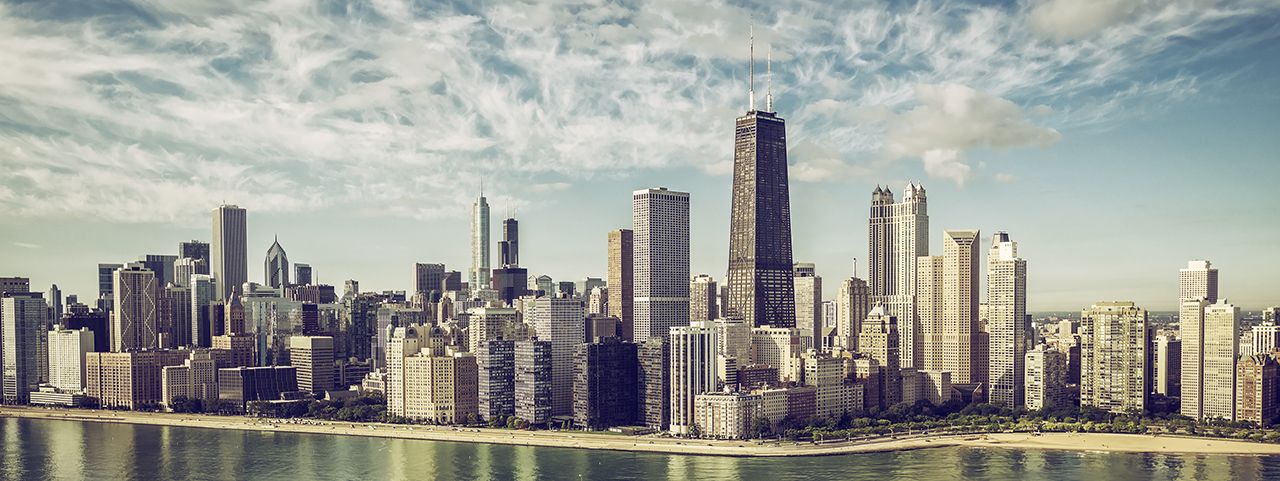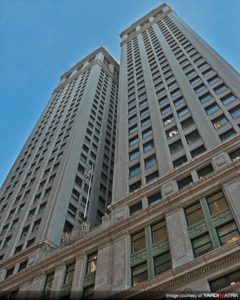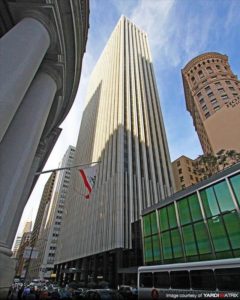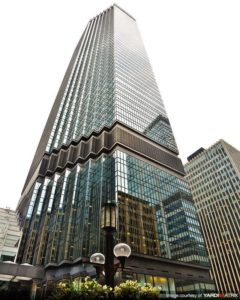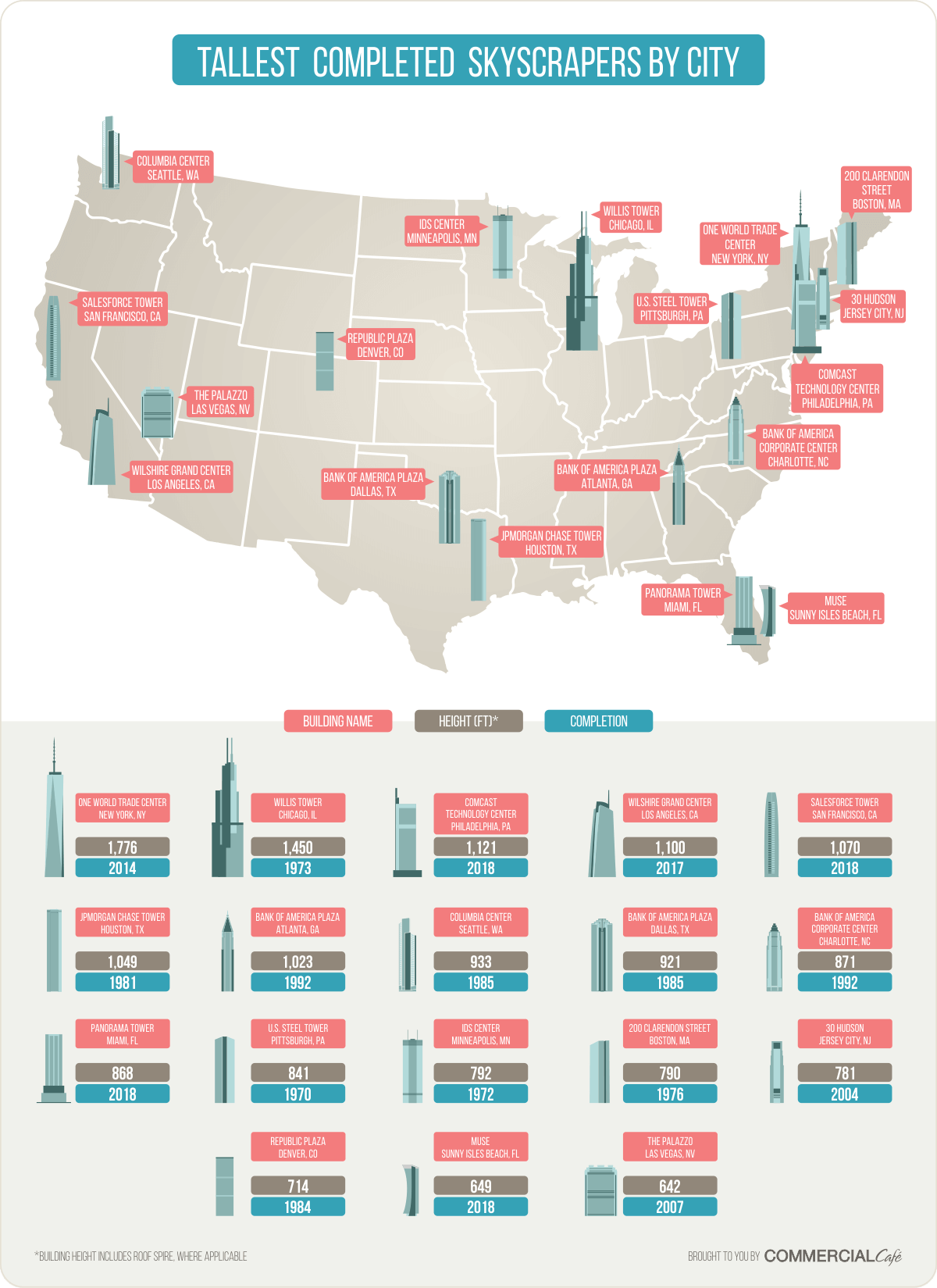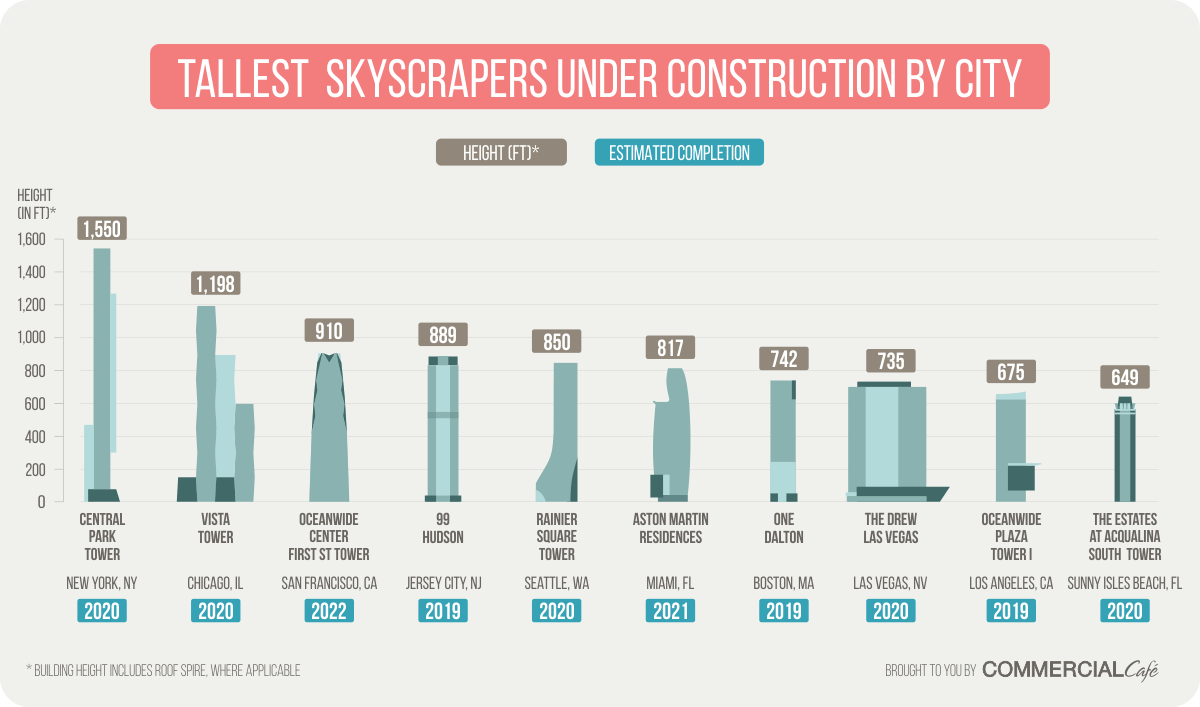Executive Summary
- The historic cultural importance of the skyscraper, and this article’s methodology;
- Mapping the skyscraper construction timeline from NYC, Chicago and Pittsburgh to the rest of the U.S.;
- America’s biggest construction boom to date kicked off in the 1960s, culminated in the 1980s;
- The post-eighties wave of supertall building is driven by residential towers;
- How the current skyscraper boom is changing the country’s cityscape;
Counting America’s Highest Rooftops and Spires—Our Methodology
Evolutions in engineering, economic cycles, major national and international events, and social changes made their mark on the nation’s cityscapes throughout history. Transformative innovations in engineering, such as the steam engine, railroads, Portland cement, and, most importantly, the use of steel as a structural material, have led to various construction booms in the country’s urban centers. As skyscrapers have reached ever-bigger heights, they have stood as symbols of economic strength and cultural prestige.
The definition of a skyscraper was subject to much discussion in the 19th century, when engineering marvels like the elevator made it viable for buildings to soar far higher than ever before. Influential architecture critic Montgomery Schuyler declared that New York’s Western Union Telegraph Building and Tribune Building should be considered the first skyscrapers, as they realized the possibilities of the elevator, and were among the first conspicuously tall buildings to rise above the average level of Manhattan’s skyline. Peruvian-born architect Francisco Mujica argued that the metallic skeleton frame embedded in the masonry, along with elevator systems, counted as defining elements, and thus considered William LeBaron Jenney’s Home Life Insurance Co. building, and Holabird & Roche’s Tacoma Building in Chicago to be the first true skyscrapers.
They were all, however, preceded by the Equitable Building at 120 Broadway in Manhattan—the first to rise twice as tall as the average five-story commercial buildings of the time. Its elevator system rendered the upper stories as rentable as the lower floors, which made the entire property financially feasible. The economic success that the Equitable Building achieved by breaking with the traditions of its past arguably encouraged engineering feats that eventually led to today’s awe-inspiring supertall structures. As this new soaring architecture became more and more commonplace in an urban setting, interest quickly shifted from what the world’s first skyscraper was, to the location of the world’s tallest skyscraper.
We set our sights on buildings that rise at least 40 stories and 500 feet, including spires. All property types were included, except non-occupiable towers, such as the Stratosphere Tower in Las Vegas. The data set also includes completed properties and buildings that are currently under construction. In the case of multiple buildings that stand on a common foundation, we counted them as one building, and the height considered reflects the tallest element in the group. Our data sources for building characteristics included Yardi Matrix, CTBUH‘s Skyscrapercenter, as well as additional proprietary research for further validation of data. We then identified 18 U.S. cities that possess at least five such buildings: Atlanta, Ga., Boston, Mass., Charlotte, N.C., Chicago, Ill., Dallas and Houston, Texas, Denver, Co., Jersey City, N.J., Las Vegas, Nv., Los Angeles and San Francisco, Calif., Miami and Sunny Isles Beach, Fla., Minneapolis, Mn., New York City, NY., Philadelphia and Pittsburgh, Pa., and Seattle, Wa.
Read on as we look back at the skyscraper construction timeline to identify the most prolific decades, see which U.S. cities boast the most impressive skylines, and reveal what new supertall building projects are currently in the works.
Mapping the Spread of the Skyscraper Throughout the U.S.
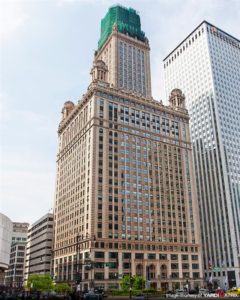
Jewelers Building, 35 East Wacker Dr.
The first U.S. building to exceed 500 feet was the Metropolitan Life Tower. This 1909 structure at 1 Madison Avenue rose 700 feet and was an imposing addition to the existing 11-story Metropolitan Life Home Office building that occupied a full block in what is now Midtown Manhattan. The MetLife tower reigned tallest in the world until 1913, when the Woolworth Building was quick to take the crown, rising 792 feet above Broadway in TriBeCa. In addition to these pioneering office buildings, a few NYC hotels also exceeded 500 feet in height at the time. The first one to be completed was the 541-foot Ritz Hotel tower, followed by the 560-foot Sheraton-Netherland. Perhaps the most famous hotel in the world, The Waldorf Astoria and Towers as we know it today, was completed in 1931 and soars 625 feet.
Chicago was the second city to see its buildings surpass the 500 foot mark. In the late 1920s, the Loop, the city’s commercial core, welcomed the 523-foot Jeweler’s Building at 35 Wacker Dr., and the slender 521-foot Mather Tower at 75 East Upper Wacker Dr. The 44-story, 605-foot Chicago Board of Trade building and the iconic Chrysler Building, towering 1,046 feet above Midtown Manhattan, were both completed in 1930. Soon after this, builders finished the iconic 1454-foot Empire State Building as well as that highlight of NYC’s Rockefeller Plaza, the 70-story, 850-foot tall 30 Rock tower, now known as the Comcast Building.
The rapid development of the iron and steel industries led to Pittsburgh becoming the third U.S. city with buildings over 500 feet tall. In 1932, the Gulf Oil Corp.’s headquarters was completed and still bears the company’s name today; the Gulf Tower has 44 floors and rises 582 feet above Downtown Pittsburgh.
Dallas’ first skyscraper was completed in 1959, as part of the city’s first mixed-use skyscraper complex, which included both hotel and office space. At the time, the development was touted as the next Rockefeller Center. The tallest of its three buildings served as headquarters for the Southland Life Insurance Co. and boasts 42 stories. With a height of 550 feet, it was the tallest building west of the Mississippi river for a time. The Downtown Dallas landmark was redeveloped and reopened nearly 30 years later as a convention hotel—the 1,844-key Adam’s Mark (currently Sheraton) was then the largest in all of Texas.
By this time, architects and developers had begun to steer away from the exuberant Art Deco style that adorned so many iconic U.S. towers. Following the Second World War, the more austere International Style became dominant, giving rise to simple, sleek, and mysterious skyscrapers that were generally faster to build.
Skyscraper Construction Takes Off During 60s, Booms During 70s, Culminates in Extravagant 80s
The 1960s marked the nation’s first major skyscraper construction boom, with more new skyscrapers built over 500 feet – more buildings of this height than had been built in the previous six decades combined. The number of such towers nearly doubled in the New York City and Chicago skylines. Completed in 1969 and standing 850 feet tall, the Chase Tower was Chicago’s match for NYC’s 30 Rockefeller Plaza, as well as America’s tallest project of the decade.
During the Soaring Sixties, a total of six more cities built skyscrapers taller than 500 feet. The massive 750-foot tall Prudential Tower was completed in 1961 in Boston’s Back Bay. Houston became the second Texas city to boast property heights in excess of 500 feet, upon completion of the 800 Bell tower, at 606 feet, and One Shell Plaza, at 714. In 1966, Downtown Atlanta became home to the tallest building in the Southeast. What is now dubbed the State of Georgia Building was constructed as the headquarters of the First National Bank of Atlanta, has 44 stories, and towers 556 feet above Peachtree Street. Also in 1966, the San Francisco skyline became the first on the West coast to top 500 feet, when the Forty Four Montgomery office tower rose 43 stories and 565 feet over the San Francisco Financial District. The Downtown L.A. skyline followed suit, with two buildings completed just one year later: in 1967, the 611 Place tower reached to 620 feet and the Union Bank Plaza topped out at 516. Finally, in 1969, the Safeco Plaza opened for business in the Seattle central business district. At 50 stories and 630 feet, it was the second-tallest skyscraper on the West coast, behind San Francisco’s 779-foot tall 555 California Street building.
The following two decades took “construction boom” to new levels, with 192 skyscrapers raised across the U.S. between 1970 and 1989. A new height benchmark had also emerged, as just over half of the towers that were built during this time exceeded 600 feet. The supertall skyscraper, classified as any building over 1,000 feet, was within reach.
The 1970s were kicked off with the construction of the massive 100-story, 1,128-foot tall John Hancock Center in Chicago. Upon completion, the tower at 875 North Michigan Ave., became the second-tallest in the world, behind the Empire State Building, which still reigned unchallenged. By the end of the decade, Chicago inched closer and closer to breaking that record. The 83-story, 1,136-foot AON Center was completed in 1972, followed shortly by the finalization of the Sears Tower (currently Willis Tower) in 1973. With that, Chicago became home to the tallest building in the world, surpassing the Empire State Building by 200 feet. Moreover, Second City was home to three supertall skyscrapers, which was one more than Manhattan.
Elsewhere in the country, the 507-foot 555 17th Street tower, formerly known as the Anaconda Tower and the Qwest Tower, was added to the Denver skyline, and Minneapolis saw the completion of the 792-foot IDS Center. The 51-story IDS office tower was accompanied by a retail wing and a 19-story hotel, all grouped around a glass-covered court that would become a sort of town square for Minneapolis. As the NYT put it, the modernist skyscraper design made a social statement, and by including space with public use in mind, “pointed the way toward the skyscraper as a social entity.”
Of the 122 towers built during the 1980s, only two exceeded 1,000 feet. Chicago got its fourth in the form of the Franklin Center at 227 West Monroe St., and the Houston cityscape made room for the JPMorgan Chase Tower at 600 Travis St. In terms of buildings that are taller than 500 feet, the infamously lucrative Eighties remain the most prolific decade in the history American skyscrapers. As major cities densified and grew in population, a flurry of extra tall hotels, corporate headquarters, bank and insurance company office towers, and residential skyscrapers sprang up all across the country. However, this rapid growth petered out in the early 90’s.
The 1990s saw a significant slump in American skyscraper construction. Only 44 buildings were completed between 1990 and 1999—roughly 64% less than during the previous decade. Residential skyscrapers that rivaled the mighty office towers were few and far between.
Residential Skyscrapers Have Yet to Catch Up with the Eighties—Peak Decade of the Office Tower
Of the cities highlighted in our research, Chicago was at the forefront of “living in the sky.” In the mid-1960s, a time when many flocked from the urban core to the green grass of the suburbs, 1000 Lake Shore Plaza was built to celebrate sophisticated city living and entertaining. In 1964, the 55-story, 590-foot multifamily property was the tallest concrete-reinforced building in the world, complete with the fastest elevators available at the time. The Marina City twin towers, Lake Point Tower—to this day unique among Chicago luxury abodes – and nine other developments similar in height and scope were built in Chicago by 1990.
While NYC was slow to follow Chicago’s lead in residential skyscrapers, the elegance of the Museum Tower, completed in 1985, more than made up for lost time. An expansion of the Museum of Modern Art, which actually occupies the first six floors of the 53-story, 588-foot building, this upscale residential high rise features a fine art collection that spans the 20th century and includes representative works in the mediums of photography, printmaking, painting, and sculpture.
Starting in the mid-1990s, construction of multifamily properties taller than 500 feet intensified. During the Eighties, the peak decade of new office towers, 10 new multifamily properties soared above 500 feet, compared to 106 new office buildings. Between 1990 and 1999, that ratio was 11 to 29, and after the year 2000, most new skyscrapers were residential. Whereas there were 31 apartment towers in the cities on our radar before 2000, 129 have been completed in the past 18 years.
63 more residential towers are currently under construction, and that’s not counting major conversions, such as One Wall Street. Built in 1931 to serve as headquarters to the Irving Trust Co., and functioning as prime Manhattan Financial District office space ever since, the 654-foot tower is being converted into condos, rentals, and retail by new owner Macklowe Properties. As major U.S. urban cores have almost run out of developable land, and newer generations choose living in the city over commuting from the suburbs, high-profile adaptive-reuse projects are on the table, along with new tower construction. The Waldorf Astoria has also recently closed, and the new owner is undertaking great efforts to preserve historic landmark elements, while creating condominiums out of roughly 1,040 of the total 1,413 hotel rooms.
How the Current Skyscraper Boom is Changing the Country’s Cityscape
So far this year, 10 skyscrapers have been marked as completed, three of which are supertalls that soar above 1,000 feet. The latest one to take the title of “tallest in the city” is the Comcast Technology Center in Philadelphia. As it happens, Comcast is simply moving the crown from atop one of its towers to another—the company’s recently delivered 1,121-foot tall Innovation and Technology Center is located across the street from Philly’s formerly tallest building, the 975-foot Comcast Center. But in the 21st Century, maybe size doesn’t matter as much as it used to, for in addition to being the most energy efficient building in the city, the tower is also the most technologically advanced development in the country. The smart building’s so-called Central Plant tracks building population and habit patterns, as well as outside weather conditions, all in order to generate only as much energy as is needed by occupants at any given moment.
Of the 18 cities we tracked for this article, 10 are home to projects exceeding 40 stories and 500 feet, that are currently under construction. Most of them will not break the city’s height record. However, they are all at least partially luxury residential units. The First Street Tower of Oceanwide Center in San Francisco will encompass office, hotel, and residential space. Upon completion, it will surpass the Transamerica Pyramid and become the city’s second-tallest building. Seattle’s Rainier Square Tower explores the same mix of uses, and will include nearly 200 luxury apartments, 722,000 square feet of office space, a 163-key hotel, and some 80,000 square feet of retail. When complete, which is estimated to be in early 2020, it will be Seattle’s second-tallest skyscraper.
With a delivery date due next year, the project at 99 Hudson St. in Jersey City will top what is now the tallest building in the entire state—30 Hudson, formerly known as the Goldman Sachs Tower. 99 Hudson is a 79-story residential skyscraper that is slated to bring 781 new Jersey City apartments for rent to the neighborhood, with prices starting at nearly $890,000.
Miami’s waterfront skyline is set to welcome the luxurious 817-foot tall Aston Martin Residences tower in 2021. In Sunny Isles Beach, Fla., there are four projects currently under construction, all designed to max out the 649-foot limit imposed in the area. Estates at Aqualina is a twin-tower residential project, of which only the South Tower is currently underway. In May, over half of the total units were already under contract, with delivery scheduled for 2020. The Residences by Armani/Casa condominium tower has just topped off, and is due for completion next fall. Turnberry Ocean Club luxury residences are underway, and the project is reportedly already 50% sold, with prices starting at $3 million. Also scheduled for completion next year is the 52-story Ritz-Carlton Residences tower.
Check out the list below for some of the most storied commercial real estate markets in the U.S., featuring available office spaces in the properties presented over the course of this article and more:

